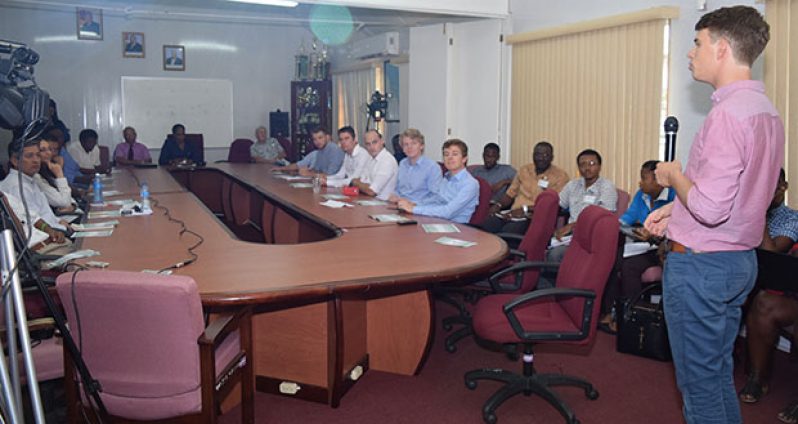A GROUP of Dutch students from Delft University of Technology on Wednesday presented the final report of Project Georgetown Drainage to the Ministries of Agriculture and Public Infrastructure.Over the last seven weeks, the seven-member Dutch Risk Reduction (DRR) team of Masters students from the Netherlands University developed a computerised (hydraulic) model for drainage in parts of Georgetown to help predict the vulnerability of certain areas during rainfall.
In delivering the presentation before Minister within the Ministry of Public Infrastructure, Annette Ferguson and Deputy Permanent Secretary of the Ministry of Agriculture, George Jervis, the Team Leader Joost Remmers explained that South Ruimveldt, Georgetown, was identified as the catchment area with attention placed on the local drainage system, primary channels, and outfall structures such as kokers.
In addition to the hydraulic model, the group, in their report, presented a number of reports and manuals. Additionally, the group of Dutch students developed several maps and tools applicable to the local system.
“With this research in the future, the Guyanese stakeholders should be able to make knowledge-based decisions to make a transition from experienced-based management of the system to knowledge-based decision-making,” he explained to reporters.
Remmers noted that the project would not have been possible without the support of the National Task Force, the National Drainage and Irrigation Authority (NDIA), the Public Infrastructure Ministry, the Mayor and City Council and the University of Guyana.
He also credited the support from the Delft University of Technology, the Dutch Embassy in Suriname, the 2015 Dutch Risk Reduction team and CDR International.
Honorary Dutch Consulate to Guyana, Ben ter Welle, said now that the study has been completed, it is now up to Government to invest in the project that would eventually result in an improved drainage network in the city known to be prone to flooding.
In delivering brief remarks in the boardroom of the Ministry of Agriculture where the presentation was made, Minister Ferguson said the Government of Guyana is indeed thankful for the excellent work put out by the students and noted that the report will be fully utilised.
“I can assure you that the Government will not allow for this report to be placed on a shelf or a desk and to accumulate dust amongst other things, but we will use the report and we will ensure that the recommendations put forward…will be effectively used,” Minister Ferguson said.
Head of the Department of Civil Engineering at the University of Guyana, Maxwell Jackson, in delivering brief remarks, said the university stands ready to further develop the project initiated by the Dutch.
“The University of Guyana, being the primary academic institution of Guyana, is going to pursue and continue that work,” he emphasised.
Already, he said students of the Department of Civil Engineering have been identified to conduct studies in areas affected by flooding. “As we speak, I have already identified some students to look at the outfall at Kitty, so the sub-catchment in the Ayanganna area…our students will be examining that.”
Sherod Duncan, Deputy Mayor of the City of Georgetown and Dr Sewnauth Punalall, Head of the National Task Force Secretariat were among other officials present during delivery of the presentation.
In November, 2015, Head of the Dutch Risk Reduction (DRR) Team Rob Steijn had told the Minister of Agriculture Noel Holder that said that the poor drainage system in the capital city must be tackled from the planning stage right up to the enforcement of legislation.
Steijn, at the time, was presenting the minister with a menu of recommendations that flowed from a careful assessment of Guyana’s drainage system.
Steijn, a social scientist, said Guyana needs to upgrade its drainage network on both technical and managerial levels. He confidently emphasised the need for an integrated approach to be taken.
Guyana’s water system is in dire need of attention, he had said, noting that the government’s predictability of water issues must be improved. As a short-term solution, Steijn said, small-scale dredging can be done.
Dutch students present final report on city’s drainage infrastructure
SHARE THIS ARTICLE :
Facebook
Twitter
WhatsApp



.jpg)








